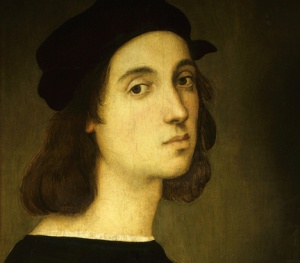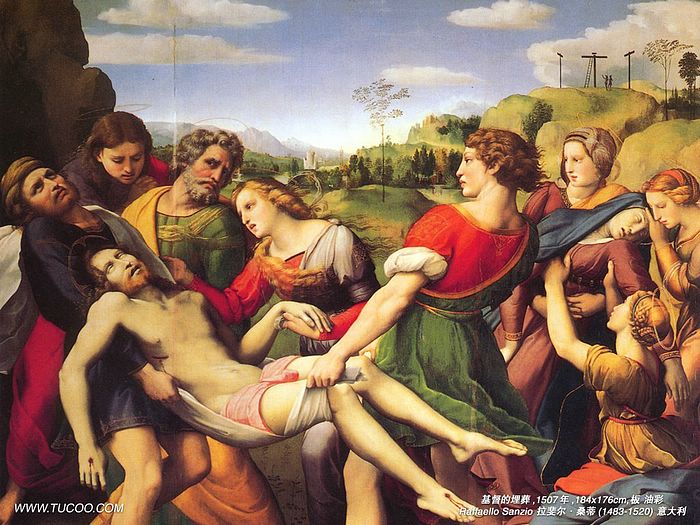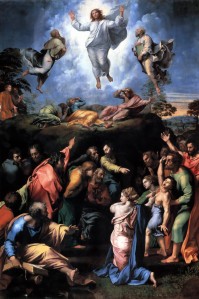 Raphael, born in Urbino, Italy in 1483, was one of three artists that made up the ‘Holy Trinity’ of the Renaissance movement. The other two, Michelangelo and Leonardo Da Vinci, are perhaps better known; this may have something to do with the fame attached to particular pieces of their work, such as Michelangelo’s sculpture, the Statue of David (1504), or Leonardo’s Mona Lisa (1507). However, Raphael’s work holds in it a beauty and depth that easily matches those also of his era, if not exceeds them. His productivity is also noteworthy; despite having died at the tender age of 37, Raphael left behind a vast collection of work. Many of his paintings remain in the Vatican, where he worked for more than a decade. It is difficult to estimate any figures, although there are examples of more than 500 Raphael oil paintings, along with thousands of sculptures, drawings and ceramics. Even if his publicist didn’t match Leonardo’s or Michelangelo’s, one cannot knock Raphael’s work ethic. This article analyses three of Raphael’s most beautiful works, one from each of the three distinctive periods of his artistic career.
Raphael, born in Urbino, Italy in 1483, was one of three artists that made up the ‘Holy Trinity’ of the Renaissance movement. The other two, Michelangelo and Leonardo Da Vinci, are perhaps better known; this may have something to do with the fame attached to particular pieces of their work, such as Michelangelo’s sculpture, the Statue of David (1504), or Leonardo’s Mona Lisa (1507). However, Raphael’s work holds in it a beauty and depth that easily matches those also of his era, if not exceeds them. His productivity is also noteworthy; despite having died at the tender age of 37, Raphael left behind a vast collection of work. Many of his paintings remain in the Vatican, where he worked for more than a decade. It is difficult to estimate any figures, although there are examples of more than 500 Raphael oil paintings, along with thousands of sculptures, drawings and ceramics. Even if his publicist didn’t match Leonardo’s or Michelangelo’s, one cannot knock Raphael’s work ethic. This article analyses three of Raphael’s most beautiful works, one from each of the three distinctive periods of his artistic career.
Umbria Years

Raphael was painting to a professional standard by his mid-teens, and worked on many different size projects in the early years of his career – from huge fresco pieces, to intricate and exquisite cabinet fronts. Most of his time was spent in Umbria, a landlocked region of central Italy. There is a significant amount of experimentation with perspective in Raphael’s earliest works; for example, in his 1502-04 work The Annunciation (pictured). This work was originally part of an altarpiece, one of three smaller works depicted below a larger painting entitled The Coronation of the Virgin, for a family chapel in Perugia. It depicts the biblical concept of the Annunciation, translated from the Latin ‘Annuntiatio nativitatis Christi’, referring to the meeting of the Virgin Mary with the angel Gabriel, where Mary was informed that she would immaculately conceive a son, Jesus Christ.
The Annunciation has an eerie tone to its subject; the lighting and perspective of the room provide a representation of the distance between God and Humanity, and likewise, the space between Gabriel and Mary is indicative of the sincerity of the situation. Despite its detail, the work is relatively simple, which may be a consequence of its physical size – around 27 x 50 cm – more than anything else. However, it is a powerful notion that Raphael has chosen to depict such an important moment in Christian theology in an artistically straightforward manner, rather than with great complication, as much Renaissance work is presented.
Florentine Years
Despite living a relatively nomadic lifestyle after leaving Umbria, Raphael is known to have spent a considerable amount of time in Florence between 1504 and 1508, where he was heavily influenced by Leonardo Da Vinci. It was around this time that Leonardo, Michelangelo and Raphael became more aware of each others work, and their styles can be witnessed as blended across the trinity. One of Raphael’s most impressive works from this period is his 1507 piece The Deposition of Christ, which was commissioned by a certain Atalanta Baglioni, whose son had been killed in a family feud – as was common within and between the Italian States and their various wars; think Niccolo Machiavelli’s work of realpolitik, The Prince (1532).

The Deposition of Christ (pictured) combines a dead Jesus Christ surrounded by his loved ones, Raphael’s depiction of the symbolic grief felt by the Baglioni family. Mary Magdalene has fainted as is being supported on the right of the work; this is a controversial image, known as the Swoon of the Virgin, it is not mentioned in any of the Four Gospels. The location of the events in the painting is unorthodox too, as it is placed neither at the crucifixion nor the entombment, but somewhere in between. Again, this could be influenced by the context of the commission; perhaps Raphael has placed the imagery in limbo between life and death as a symbol of the Baglioni family’s sorrow.
Roman Period

Raphael was invited to work for Pope Julius II, and undertook works of new magnitude, in both the visual and political sense. In Rome, he often worked in direct competition with Michelangelo, who is known to have publically disliked Raphael. Thought to be his final work, The Transfiguration (1516-20, pictured), which depicts the rare image of the transformed Christ in Heaven, above the Apostles, who are attempting an exorcism. The painting was commissioned by Cardinal Giulio De Medici, of the famous Medici family, who would later become Pope Clement VII after Raphael’s death.
The Transfiguration is a beautiful example of Raphael’s ability to combine detail and mystery. The contrast of general light above and dark below sets on edge the events in the lower register, the figures of whom appear toned and subservient to the light above. On a simple level, the painting can be considered to depict a dichotomy, not of Heaven and Hell, but of Redemption and Sin, and the relationship between the two: the flaws of man to be transfigured, as such. Raphael worked on The Transfiguration until his death; some believe that he considered it his magnum opus.
Conclusion
Raphael, despite his differences with his artistic colleagues, was undoubtedly influenced by their work. The beauty of the Renaissance is that is produced a set of artists each with a unique tone and edge to their work, but with a sweeping trend of blurred mystery, piety and sincerity. Even within their collections, each painter has his own variety of image, and yet a distinctive brushstroke to sign off their masterpieces. Raphael’s own productions are endless in depth and splendour; it is difficult to find a counterpart as prolific.